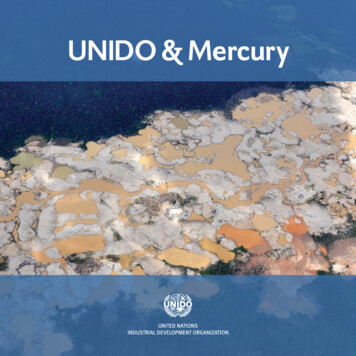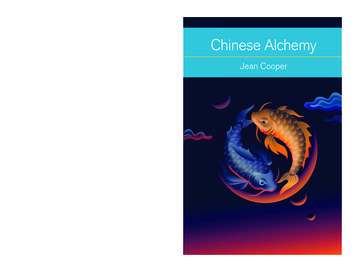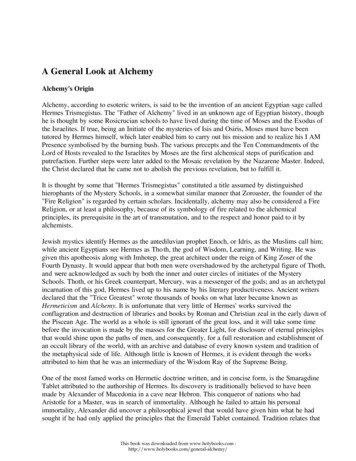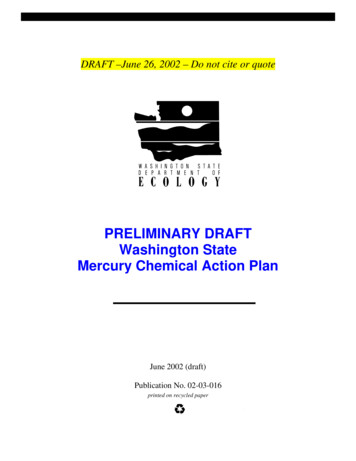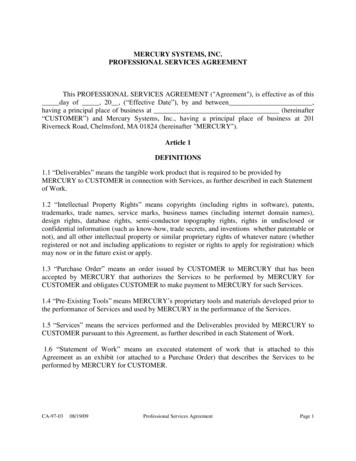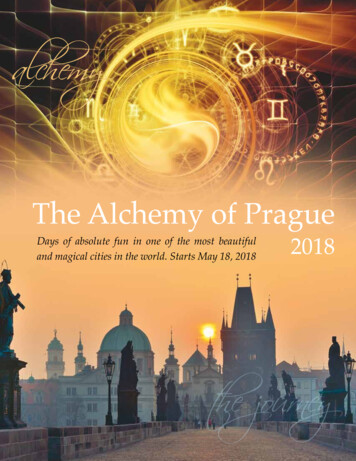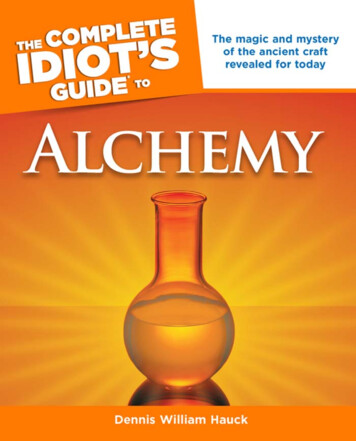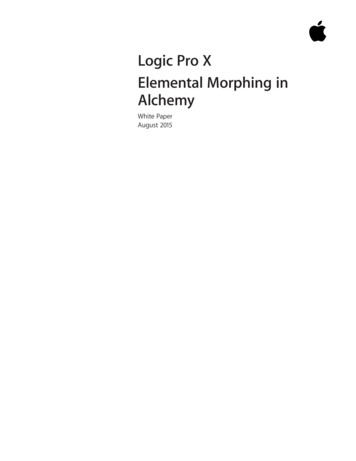
Transcription
Alchemy salt sulphur mercuryNext
Alchemy salt sulphur mercury
“Alquimista” redirects here. For other uses, see Alchemist (disambiguation) and Alchemy (disambiguation). Branch of the ancient natural philosophy Protoscientific Kimiya-yi saâ à  dat (The Alchemy of Happiness), a text on Islamic philosophy and alchemy by the Persian philosopher and mystic Al-Ghazà  là (century) XI) Ouroboros' representation ofthe alchemical treatise Aurora consurgens (15th century), Zentralb Library of Zurich, Switzerland Alchemy (from Arabic: al-kà ”miyà  ; from ancient Greek: khumeà  a) [1] is an ancient branch of natural philosophy, a a philosophical and proto-scientific tradition that has been historically practiced in China, India, the Muslim world, and Europe.[2] Inits Western form, alchemy is first attested in a series of pseudo-epigraphic texts written in Greco-Roman Egypt during the first centuries A.D.[3] The common objectives were crystopoeia, the transmutation of “basic metals” (e.g., lead) into “noble metals” (particularly gold);[2] the creation of an elixir of immortality;[2] and the creation of panaceascapable of curing any disease.[6] It was thought that the perfection of the human body and soul was the result of the alchemical work magnum (“Great Work”).[2] The concept of creating the Philosopher’s Stone was related in various ways to all these projects. Islamic and European alchemists developed a basic set of laboratory techniques, theoriesand terms, some of which are still in use today. They did not abandon the Ancient Greek philosophical idea that everything consists of four elements, and tended to keep their work secret, often using cryptic ciphers and symbolisms. In Europe, the twelfth-century translations of medieval Islamic science and the rediscovery of Aristotelian philosophygave rise to a flourishing tradition of the Latina. [2] This late medieval alchemy tradition would continue to carry out an important role in the development of the (particularly chemistry and medicine).[7] Modern discussions about alchemy are usually divided into an examination of its exoteric practical applications and its esoteric spiritual aspects,despite the criticism of scholars such as Eric J. Holmyard and Marie-Louise von Franz that they should be understood as complementary.[8] and the philosophical and religious contexts in which these events took place. The latter is of interest to historians of esotericism, psychologists and some philosophers and spiritualists. The theme has also had aconstant impact on literature and the arts. Etymology See also: Etymology of chemistry The word alchemy comes from the old French alchemie, alkimie, used in medieval Latin as alchemia. This name is derived from the Arabic word al-kÔmiyà(à à à ÃÃÃÃÃÃÃà ̈ ̈ ̈ ̈ ̈ ̈ ̈ ̈ ̈ ̈ ̈ ̈ ̈ ̈ ̈ ̈ ̈ ̈ ̈ ̈ ̈ ̈ ̈: el tà rmino greego tardÃo khÃ̈âÂa (eskiegoÃ·Ã Â·Ã Ì ̈à Ì), also deletreado khumeia (eskiegoà ̈ ̈ ̈à 4à ̈Ã Ì ̈Ã Ì ̈à à à and khÃÄ”mÃÂa (Ãzecà ·à Ì ) â see below, and the defined article in Arabic al- (Ã Â§Ã Ì Ì Ì Ì Ì ), which means âEl'.[10] Together This association can be interpreted as “the process of transmutation by which it fuses or reunites with the divineor original form”. Several etymologies have been proposed for the Greek term. The first was proposed by ZÃ3simos of PanÃ3polis (3rd and 4th centuries), who derived it from the name of a book, the Khemeu.[11] Hermanm Diels argued in 1914 that it was more derived from the Âzecà 4à  ,[13] used to describe metallic objects made up of [14]Others trace their roots to the Egyptian name 2 khmi), which means “black earth”, which refers to the fertile soil. The Arab word al-kÔmiyaà ̈3â4 actually means “the Egyptian [science]”, borrowing from the Coptic word for para, according to the Egyptian philosopher Wallis Budge. kÃÄ”me (or its equivalentin the medieval Boharian dialect of Coptic, kà Ĕme). This Coptic word is derived from kmá” of DemÃ3tica, in turn from the ancient Egyptian kmt. The ancient Egyptian word referred to both the country and the color “black” (Egypt was the “Black Land”, as opposed to the “Red Land”, the surrounding desert); so this etymology could also explain thenickname “Egyptian black art.” History Alchemy encompasses several philosophical traditions spanning about four millennia and three continents. The general inclination of these traditions towards the cryptic and symbolic language makes it difficult to trace their mutual influences and their “genetic” relationships. At least three major strands can bedistinguished, which seem to be largely independent, at least in their early stages: Chinese alchemy, centred on China, and alchemy. Indian chemistry, centered on the Indian subcontinent; and Western alchemy, which occurred around the Mediterranean and whose center has shifted over the millennia from Greco-Roman Egypt to the Islamic world,and finally to medieval Europe. Chinese alchemy was closely related to Taoism and Indian alchemy to Dharmic beliefs. In contrast, Western alchemy developed its philosophical system largely independent but influenced by several Western religions. It remains to be seen whether these three strands share a common origin or to what extent theyinfluenced each other. Hellenistic Egypt Part of a series on Hermeticism Mythology Hermes Trismegistus Hermetic arts Astrology Alchemy Hermetic Magic Hermetic Writings Liber Hermetis (astrological) Definitions of Hermes Trismegistus Corpus Hermeticum Asclepius Discourse on the 8th and 9th Koran kosmou Cyranides The Book of Secret TheStars The Secret of Creation Emerald Tablet Kità  b al-Isá1-amà khà â s Liber Hermetis of alchemy Related historical figures (ancient and medieval) ZÃ3simos de Pan Jà  bir Ì ì§ayyà "â œNe (can be legendary) Abà ⠜Shang ibn Umayl Maslama al-Quráño1âundo"  »â§â Mad al-Bà . » Nà " -Bell .  »NÃ"  » Figures (Modern Modern)Marsilio Ficino Lodovico Lazzarelli Giovanni Da Correggio Pico della Mirandola Heinrich Cornelius Agripa Paracelsus John Dee Giordano Bruno Jakob Boehme Robert Fludd Christian Rosenkreuz (Legendary, see Rosicrucianism) Modern offshoots as above, below the hermetic order of the Golden Dawn. Kybalion Vte Ambix, Cucurbit and Retort deZosimos, by Marcelin Berthelot, Collection des Anciens Alchimistes Grabs (3 vols., Paris, 1887, 1888). The beginning of Western alchemy can usually be traced back to ancient and Hellenistic Egypt, where the city of Alexandria was a center of alchemical knowledge, and retained its preeminence through most of the Greek and Roman periods. [15]Following the work of Andrà -Jean Festugià ̈re, modern academics see alchemical practice in the Roman Empire as originating in the art of Egyptian goldsmithing, Greek philosophy and different religious traditions. [16] Tracing the origins of alchemical art in Egypt is complicated by the pseudepigraphic nature of the texts of the Greek alchemicalcorpus. The treatises of Zosimos of Panopolis, the first historically attested author (FL. C. 300 CE), [17] may help to situate the other authors. Zosimus based his work on that of the oldest alchemical authors, such as Marah, the Judea, [18] pseudo-dememeters, [19] and Agathodaimon, but very little is known about any of these authors. The mostcomplete of his works, the four pseudo-democratic books, were probably written in the A.D. century. [19] The recent scholarship tends to emphasize the testimony of Zosimus, who traced the alchemical arts to Egyptian metallurgical and ceremonial practices. [20] [21] [22] It has also been argued that the early alchemical writers borrowed thevocabulary of the Greek schools of philosophy, but did not implement any of their doctrines in a systematic way. [23] Zosimus of Panopolis wrote in abstinence (also known as the "final count"). [24] Zosimos explains that the ancient practice of "tinctures" (the technique. Technical. name of the alchemical arts) had been taken over by certain “demons”who taught the art only to those who offered sacrifices. Since ZÃ3simos also called the demons “guardians of places” (it’s 4 to Ì ̈ ̈ ̈ ̈ ̈ ̈ ̈ ̈ ̈ ̈ ̈ ̈ ̈ ̈ ̈ ̈ ̈ ̈ ̈ ̈ ̈ ̈ ̈ ̈ ̈ ̈ ̈ ̈ ̈ ̈ ̈ ̈ ̈ ̈ ̈ ̈ ̈ ̈ ̈ ̈ ̈ ̈ ̈ ̈ ̈ ̈ ̈ ̈ ̈ ̈ ̈ ̈ ̈ ̈ ̈ ̈ ̈ ̈ ̈ ̈ ̈ ̈ ̈ ̈ ̈ ̈ ̈ ̈ ̈ ̈ ̈ ̈ ̈ ̈ ̈ ̈ ̈ ̈ ̈ ̈ ̈ ̈ ̈ ̈ ̈ ̈ ̈ 1) and those who offered sacrifices to them “priests” (à1â4 ÃÎ1 4à à à à ), it is quite clear. that he referred to the gods of Egypt and their priests. Whilecriticizing the type of alchemy he associated with the Egyptian priests and their followers, ZÃ3simos considered that the recent past of the tradition was rooted in the rites of Egyptian temples.[25] Mythology “ZÃ3simos of Panopolis claimed that alchemy dates back to Pharaoh Egypt. This was the rule of the priestly class, although there is little or noevidence for its assertion.[26] Alchemical writers used classical figures from Greek, Roman, and Egyptian mythology to illuminate their works and allegorize alchemical transmutation.[27] These included They are the pantheon of gods related to the classic planets, Isis, Osiris, Jason, and many others. The central figure in the mythology of alchemy isHermes Trismegistus (or Three times-Great Hermes). Its name derives from the god Thoth and its Greek counterpart Hermes.[28] Hermes and its caduceus, or serpent’s rod, were among the main symbols of alchemy. According to Clement of Alexandria, he wrote the so-called “Forty-Two Books of Hermes”, which covered all fields of knowledge.[29]The Hermetics of Threefold-Great Hermes is generally understood as the basis of Western alchemical philosophy and practice, called the philosopher. hermetic by its first practitioners. These writings were collected in the first centuries of the Common Era. Technology “The beginnings of Western alchemy are sometimes associated with those ofmetallurgy, which date back to 3500 B.C.[30] Many writings were lost when the Roman emperor Diocletian ordered the burning of alchemical books[31] after A revolt in Alexandria (292 D.C.). Few original Egyptian documents on envelope They have survived, most notable among them, the papyrus of Stockholm and the papyrus of Leyden X. datingback to AD 250 “300, contained recipes for dyeing and making artificial gemstones, cleaning and making pearls, and making imitation gold and silver. [citation required ] These writings lack the mystical and philosophical elements of alchemy, but they contain the works of bolo of Mendes (or pseudo-democratic), which aligned these recipes with thetheoretical knowledge of astrology and the classical elements. [32] Between the time of Bolus and Zosimos, the change took place that transformed this metallurgy into a hermetic art. [33] Philosophy: Alexandria acted as a fusion pot for philosophies of Pythagoreanism, Platonism, Stoicism and Gnosticism that formed the origin of the character ofalchemy. [32] An important example of the roots of alchemy in Greek philosophy, originated by Empedocles and developed by Aristotle, was that all things in the universe were formed from only four elements: earth, air, water and fire. According to Aristotle, each element had a sphere to which it belonged and to which it would return if leftuninterrupted. [34] The four elements of the Greek were mostly qualitative aspects of matter, not quantitative, as are our modern elements; “. True alchemy never considered earth, air, water and fire as bodily or chemical substances in the present sense of the word. The four elements are merely the principal qualities, and most of the generalqualities, of which the amorphous. and the purely quantitative substance of all bodies is first revealed in a differentiated way”. [35] Later alchemists developed extensively the mystical aspects of this concept. Alchemy coexisted along with emerging Christianity. Lactantius believed that Hermes Trismegistus had prophesied his birth. Stà Augustinelater affirmed in the 4th and 5th centuries, but he also condemned Trismegistus for idolatry. [36] Examples of pagan, Christian and Jewish alchemists can be found during this period. The majority majority The Greco-Roman alchemists who preceded Zosimus are known only by pseudonyms, such as Moses, Isis, Cleopatra, Democritus and Ostanes.Other authors such as Komarios and Chymes, we only know them through text fragments. After 400 AD, Greek alchemical writers devoted themselves exclusively to commenting on the works of these predecessors.[37] By the mid-7th century alchemy was almost a mystical discipline.[38] It was then that Khalid Ibn Yazid began his migration fromAlexandria to the Islamic world. by facilitating the translation and preservation of Greek alchemical texts in the eighth and ninth centuries.[39] Byzantine Greek alchemy is preserved in medieval (Byzantine) Greek manuscripts, yet historians have only begun to pay attention to the study and development of the Greek alchemy in the Byzantine period.[40] India Main article: Rasayana See also: History of metallurgy in the Indian subcontinent The Vedas text of the second millennium B.C. describes a connection between eternal life and gold.[41] Considerable knowledge of metallurgy has been exposed. in a 3rd century A.D. text called Arthashastra, which provides ingredients for explosives(Agniyoga) and salts extracted from fertile soils and plant remains (Yavakshara) such as saltpeter/nitro, perfume (different qualities of perfumes are mentioned), granulate (refined) Sugar.[43] [44] [45] Buddhist texts from the 2nd to 5th centuries mention the transmutation of base metals into gold. According to some scholars, Greek alchemy mayhave influenced Indian alchemy, but there is no hard evidence to support this claim.[41] The 11th century Persian chemist and physician Abà ”Rayhà Bà rà ”nà ”, who visited Guj As part of the court of Mahmud of Ghazni, he reported that they have a science similar to alchemy that is quite peculiar to them, which in Sanskrit is called Rasayà a andin Persian Rasavà Åtam. It means the art of RASA: Nà ctar, mercury and juice. This art art restricted to certain operations, metals, drugs, compounds and medicines, many of which have mercury as their central element. Its principles restored the health of those who were sick beyond all hope and brought youth back to a fading old age.The aims ofalchemy in India included the creation of a divine body (signed divya-deham) and immortality while still incarnated (without the incarnation) written jà ”van-mukti). The signed alchemical texts include much material on the handling of mercury and sulfur, which are homologated with the semen of the god Ãwiva and the menstrual blood of the goddessDevà . Some of the early alchemical writings seem to have their origins in the Ka’tric schools. associated with the teachings of Matsyendranath’s personality. Other early writings are found in the medical treatise Jaina Kalyà  á1skiegoakà  rakam of Ugrà  ditya, written in southern India at the beginning of the ninth century.[46] Two famous Indianalchemical authors were Nà  g rjuna Siddha and Nityanö Taha Siddha. Nagarrjuna Siddha was a Buddhist monk. His book, Rasendramangalam, is an example of Indian alchemy and medicine. Nityana Siddha wrote Rasaratnà kara, also a very influential work. In Sanskrit, rasa translates as “mercury”, and Nà  gà  rjuna Siddha is said to havedeveloped a method for converting mercury into gold.[47] Studies on Indian alchemy can be found in the publication of David Gordon White’s The Alchemical Body.[48] White ha written a modern bibliography on Indian alchemical studies.[49] The content of 39 signed alchemical treatises has been analyzed in detail in G. Jan Meulenbeld’s History ofIndian Medical Literature.[50] Discussion of these works at HIML provides a summary of the content of each work, its special characteristics, and, where possible, the evidence relating to its dating. Chapter 13 of HIML, Various works on rasa and (Or several works on alchemy and gems) gives details of another 655 treaties (six hundred fifty-five). Insome cases cases gives notes on the content and authorship of these works; in other cases, reference is made only to unpublished manuscripts of these titles. Much remains to be discovered about the Indian alchemical literature. The content of the signed alchemical corpus has not yet been properly integrated (2014) into the general history ofalchemy. Islamic world Main article: Alchemy and chemistry in medieval Islam 15th century art print by Jabir ibn Hayyan (Geber), Codici Ashburnhamiani 1166, Biblioteca Medicea Laurenziana, Florence. After the fall of the Roman Empire, the focus of alchemical development shifted to the Islamic world. Much more is known about Islamic alchemybecause it was better documented: in fact, most of the earlier writings that have appeared over the years have been preserved as Arabic translations.[52] The word alchemy itself is derived from the Arabic word al-kà ”miyà ”  (that’s it). The primitive Islamic world was a melting pot of alchemy. Platonic and Aristotelian thought, which had alreadybeen somewhat appropriate in Hermetic science, continued to be assimilated during the late seventh and early eighth centuries through Syriac translations and scholarship. In the late 9th and early 10th centuries, the Arabic works attributed to Jà Åbir ibn Hayyà Ån (Latinized as “Geber” or “Geberus”) introduced a new approach to alchemy. PaulKraus, who wrote the standard reference work on Jabir, put it this way: To get an idea of the historical place of Jabir’s alchemy and address the problem of its sources, it is advisable to compare it with what remains of the Greek-language alchemical literature. One knows in what miserable state this literature came to us. Collected by Byzantinescientists of the 10th century, the corpus of Greek alchemists is a cluster of incoherent fragments dating back to all times from the 3rd century to the end of the Middle Ages. Berthelot’s efforts and To put put on Subsequent researchers, including Mrs. Hammer-Jensen, tannery, Lagercrantz, von Lippmann, Reitzenstein, Ruska, Bidez, Festugià ̈re andothers, were able to clarify only a few details. The study of the Greek alchemists is not very encouraging. A cursory examination of the Greek texts shows that only a very small part was organized according to true laboratory experiments: even the supposedly technical writings, in the state in which we find them today, are an unintelligible nonsensethat denies any interpretation. It’s different with Jabir’s alchemy. The relatively clear description of alchemical processes and apparatuses, the methodical classification of substances, mark an experimental spirit far removed from the strange and strange esotericism of the Greek texts. The theory on which Jabir bases his operations is one of clarityand impressive unity. More than with the other Arab authors, there is a balance between theoretical teaching and practice, between â ilm and amal. It would be in vain to look in the Greek texts for a work as systematic as the one presented, for example, in the Book of the Seventy[53]. Islamic philosophers also made great contributions to alchemicalhermeticism. The most influential author in this regard was probably Jabir. The ultimate goal of Jabir was Takwin, the artificial creation of life in the alchemical laboratory, up to, and including, human life. He analyzed each Aristotelian element in terms of four basic qualities: itching, coldness, dryness, and moisture.[54] According to Jabir, in eachmetal two of these qualities were interior and two exterior. For example, lead was externally cold and dry, while gold was hot and humid. Therefore, Jabir theorized that by rearranging the qualities of one metal, another metal would result.[54] With this reasoning, the search for the philosopher’s stone was to Western alchemy. Jabir developed anelaborate numerology in which the root letters of the name of a substance in Arabic, when treated with various transformations, corresponded to the physical properties of the element. The elemental system used in medieval alchemy also originated with Jabir. Its original system consisted of seven elements, which included the five classic elements(ether, air, earth, fire and water), as well as two chemical elements representing the metals: sulphur, the “burning stone”, which characterized the principle of fuel, and mercury, which contained the idealized principle of metallic properties. in eight elements, with the Arab concept of the three metallic principles: sulfur that gives flammability or fuel,mercury that gives volatility and stability, and salt that gives solidity.[55][verification required][best source needed][discuss doubtful] The theory tied Corpuscularism, where all physical bodies possess an inner and outer layer of tiny particles or corpus , also has its origins in the work of Jabir.[56] Between the 9th and 14th centuries, alchemicaltheories were criticized by a variety of Muslim chemists, including Alkindus,[57] Abà ” al-Rayhà ” al-Bà ”rà ”nÔ,[58] Avicena[59] and Ibn KhaldÃon. In particular, they wrote refutations against the idea of metal transmutation. East Asia Main article: Chinese Alchemy Taoist alchemists often use this alternative version of taijitu. While Europeanalchemy eventually focused on the transmutation of base metals into noble metals, Chinese alchemy had a more obvious connection with medicine.[60] The philosopher’s stone of European alchemists can be compared to the Great Elixir of Immortality sought by Chinese alchemists. From the Hermetic point of view, these two objectives were notdisconnected, and the philosopher’s stone was often equated with the universal; therefore, the two objective objectives You may have had more commonly than it seems initially. Black fly may have been an important invention of Chinese alchemists. As stated earlier, Chinese alchemy was more related to medicine. It is said that the Chinese inventedthe fly as they tried to find a potion for eternal life. Described in texts of the IX century [citation needed] and used in fireworks in China in the tenth century, [Appointment required] was used in 490 drops. [Mecouragement] From China, the use of pel Japan, the Mongols, the Muslim world Europe. The fly was used by the Mongols against the huntersin 1241, and in Europe in the 14th century. Chinese alchemy was closely related to Taoid forms of traditional Chinese medicine, such as acupuncture and moxibustification. [60] At the beginning of the Song dynasty, the followers of this taoÃsta idea (mainly the height and the high class) ingested mercüric sulfide, which, although tolerable at lowlevels, brought many to suicide. Thinking that this consequent death would lead freedom and access to the TaoÃsta heaven, the subsequent deaths encouraged people to avoid this alchemy method in favor of external sources [citation needed] (the aforementioned Tai Chi Chuan, [Quote Necessary] Domain of Qi, [Mecouragement] etc.) Chinesealchemy was introduced in the West by Obed Simon Johnson. [60] Medieval Europe The alchemist in search of the Philosopher's Stone, by Joseph Wright, 1771  «An illuminated page of a book on alchummic processes and recipes», ca. XV century. The introduction of alchemy in Latin Europe can be dounced on February 11, 1144, with the completionof the translation of Roberto de Chester from the Book of Alchemy composition. Although European artisans and technical were pre-existing, Robert scores on him in his preface that alchemy (although here refers more than elixir than art himself) [61] was In Latin Europe at the time of writing it. Translation of Arabic texts related to A Disciplines likeAlchemy flourished in Toledo, Spain, in the 12th century, thanks to collaborators such as Gerardo de Cremona and Addelado de Bath. [62] The translations of the little include the peat philosophorum, and the works of Avicena and Al-Razi. These brought with it many new words to the European vocabulary for which there was no previous Latinequivalent. Alcohol, Carboy, Elixir and Athanor are examples. [63] Meanwhile, the contemporary telloes of the translators took steps towards the reconciliation of experimental faith and rationalism, preparing to Europe for the influence of alchumic thinking. San Anselmo, from the 11th century, raised the idea that faith and rationalism werecompatible and fostered rationalism in a Christian context. At the beginning of the 12th century, Pedro Abelardo followed the work of Anselmo, laying the foundations for the acceptance of Aristothel thought before the first works of Aristotle arrived in the West. At the beginning of the thirteenth century, Robert Grossetete used the methods ofAnalysis of Abelard and added the use of observation, experimentation and conclusions when carrying out scientific research. Grossetetes you also worked a lot to reconcile Platonic and Aristothel thought. [64] During a large part of the XII and XIII centuries, alchumic knowledge in Europe remained focused on translations, and no Latin contributionswere made. The efforts of the translators were followed by that of the encyclopedists. In the thirteenth century, Albertus Magnus and Roger Bacon were the most remarkable of them, their work summarizing and explaining the alchumic knowledge of imported in Aristothel terms. [65] Albertus Magnus, a Dominican friar, is known for writing works asthe Book of Minerals where he observed and commented on the operations and theories of alchimic authorities such as Hermes and Democritus and anonymous alchemists of him. Alberto compared them critically with the of Aristotle and Avicenna, where they referred to the of metals. From shortly after his death to the 15th century, he waserroneously credited with more than 28 alchemical treatises, a common practice that gave him a reputation as an accomplished alchemist.[66] Similarly, the alchemical texts have been credited to the student of Albert Thomas Aquinas. Roger Bacon, a Franciscan friar who wrote on a wide variety of subjects, including optics, comparative linguisticsand medicine, composed his Great Work (Latin: Opus Majus) for Pope Clement IV as part of a project to reconstruct the medieval university curriculum to include the new learning of his time. Although alchemy was not more important to him than other sciences and did not produce allegorical works on the subject, he did consider it and astrology asimportant parts of natural philosophy and theology and his contributions advanced the connections of alchemy with soteriology and Christian theology.ana. Bacon’s writings integrated morality, salvation, alchemy and the prolongation of life. His correspondence with Clement highlighted this point, pointing to the importance of alchemy to the papacy.[67] Like the Greeks before him, Bacon recognized the division of alchemy into practical and theoretical spheres. He pointed out that the theory was beyond the reach of Aristotle, the natural philosophers and all the Latin writers of his time. Practice confirmed the theory, and Bacon defended its uses in the natural sciences and medicine.[68] In laterEuropean legend, he became an archimago. In particular, together with Albert the Great, he is credited with forging a brazen head able to answer the questions of its owner. Shortly after Bacon, the influential work of Pseudo-Geber (sometimes identified as Paul of Taranto) appeared. His Summa Perfectionis remained a basic summary of alchemicalpractice and theory through the medieval and Renaissance periods. Outstanding for its inclusion of practical chemical operations with the theory of sulfur and mercury, and by the unusual clarity clarity [69] By the end of the 13th century, alchemy had become a fairly structured belief system. The followers believed in the macrocosm-microcosmtheories of Hermes, that is, they believed that processes involving minerals and other substances could have an effect on the human body (for example, if you learned the secret of purifying gold, you could use the technique to purify the human soul).). They believed in the four elements and four qualities described above, and had a strong tradition ofcamouflaging their written ideas in a labyrinth of coded jargon with traps to deceive the uninitiated. Finally, the alchemists practiced their art: they actively experimented with chemicals and made observations and theories about how the universe worked. His whole philosophy revolved around his belief that the soul of man was divided within himselfafter the fall of Adam. By purifying the two parts of man’s soul, man can be reunited with God.[70] In the fourteenth century, alchemy became more accessible to Europeans outside the confines of Latin-speaking ecclesiastics and scholars. The alchemical discourse moved from academic philosophical debate to an expounded social commentary on thealchemists themselves.[71] Dante, Piers Plowman, and Chaucer painted unflattering pictures of alchemists as thieves and liars. Pope John XXII’s edict of 1317, Spondent quas non-exhibent, forbade the false promises of transmutation made by pseudo-alchemists.[72] In 1403, Henry IV of England forbade the practice of metal multiplication. (althoughit was possible to buy a license to try to make gold alchemically, and some were granted by Henry VI and Edward IV.[73]) These criticisms and regulations focused more on pseudo-alchemical charlatanism than on the actual study of alchemy, which continued with an increasingly Christian tone. The fourteenth century saw Christian Death andResurrection images used in the alchumic texts of Petrus Bonus, Bonus, of Rupescissa, and in works written on behalf of Raymond Llull and Arnold de Villanova.[74] Nicolás Flamel is a well-known alchemist, but a good example of pseudo-epigraphy, the practice of naming your works after someone else, usually more famous. Although the historicalFlamel existed, the writings and legends attributed to i
Hermes Trismegistus (or Three times-Great Hermes). Its name derives from the god Thoth and its Greek counterpart Hermes.[28] Hermes and its caduceus, or serpent's rod, were among the main symbols of alchemy. According to Clement of Alexandria, he wrote the so-called "Forty-Two Books of Hermes", which covered all fields of knowledge.[29]
